Identification of Typical Solid Hazardous Chemicals Based on Hyperspectral Imaging
Abstract
:1. Introduction
2. Materials and Methods
2.1. Experimental Samples and Targets Preparation
2.2. Test Equipment and Spectrum Collection Method
2.3. Fast Extraction Technology of Spectral Information and Identification Method
3. Results and Discussion
3.1. Establishment of Spectral Database
3.2. Spectral Data for the Hazardous Chemicals in the Actual Environment
3.3. Identification of Hazardous Chemicals Based on Spectral Feature Matching
3.4. Matching Degree of Spectral Curves of Hazardous Chemicals
4. Conclusions
- The four hazardous chemicals of sulfur, red phosphorus, potassium permanganate and corn starch had bright colors, obvious spectral curve characteristics, and obvious changes in reflectivity with wavelength. They were relatively easy to identify through the whole waveform and spectral characteristics matching method, although the relationship between the richness of sample color and the spectral characteristics needs to be further studied.
- The spectral characteristics of the targets carbon powder, strontium nitrate, wheat starch, and magnesium–aluminum alloy powder were not obvious, with no characteristic peaks, and no distinct changes in reflectivity with wavelength. Moreover, except for the reflectivity of the target carbon powder remaining at a low level, the reflectivity values of the remaining three sample targets were relatively close and it was difficult to identify them only from spectral matching. For these types of hazardous chemicals with similar reflectivity–wavelength curves, a combination of reflectivity value and color should be additionally considered for further identification.
- A quantitative method to characterize the matching degree of the spectral curves of hazardous chemicals was proposed, which can well characterize the matching degree of the spectral curves with the consideration of the difference between the reflectivity of the spectral curves and the reflectivity of the sample in the spectral database. It can be known by calculation that for the four hazardous chemicals with obvious spectral characteristics, sulfur, red phosphorus, potassium permanganate, and corn starch, the matching degree of their spectral curves was positively correlated with their reflectivity.
- In summary, this research provided a means and method to identify hazardous chemicals using hyperspectral imaging and comparison of spectral characteristics, and demonstrated its feasibility and presented identification results. Moreover, the spectral matching degree of hazardous chemicals was characterized by a quantitative method. Based on this, a certain theoretical framework and experimental results are established, which are of great significance for the detection and early warning of hazardous chemicals and expansion of the applications of hyperspectral imaging. Future works can focus on further increasing the types of typical hazardous chemicals to expand the spectral database.
Author Contributions
Funding
Data Availability Statement
Conflicts of Interest
References
- Yang, S.; Fan, W.; Cheng, H.; Gong, Z.; Wang, D.; Fan, M.; Huang, B. A dual functional cotton swab sensor for rapid on-site naked-eye sensing of nitro explosives on surfaces. Microchem. J. 2020, 159, 105398. [Google Scholar] [CrossRef]
- Hay, C.E.; Lee, J.; Silvester, D.S. A methodology to detect explosive residues using a gelled ionic liquid based field-deployable electrochemical device. J. Electroanal. Chem. 2020, 872, 114046. [Google Scholar] [CrossRef]
- Schachel, T.D.; Stork, A.; Schulte-Ladbeck, R.; Vielhaber, T.; Karst, U. Identification and differentiation of commercial and military explosives via high performance liquid chromatography–high resolution mass spectrometry (HPLC-HRMS), X-ray diffractometry (XRD) and X-ray fluorescence spectroscopy (XRF): Towards a forensic s. Forensic Sci. Int. 2020, 308, 110180. [Google Scholar] [CrossRef]
- Hossny, K.; Magdi, S.; Soliman, A.Y.; Hossny, A.H. Detecting explosives by PGNAA using KNN Regressors and decision tree classifier: A proof of concept. Prog. Nucl. Energy 2020, 124, 103332. [Google Scholar] [CrossRef]
- Al-Mousawi, A.J. Magnetic Explosives Detection System (MEDS) based on wireless sensor network and machine learning. Measurement 2020, 151, 107112. [Google Scholar] [CrossRef]
- Zhao, Y.; Guan, Q.L.; Bai, F.Y.; Xing, Y.H.; Sun, L.X. An inorganic-organic hydrogen cluster: Fluorescence response of the high efficient detection of Fe3+, OH− and nitro explosives. J. Mol. Struct. 2021, 1225, 129115. [Google Scholar] [CrossRef]
- Frazier, J.; Benefield, V.; Zhang, M. Practical investigation of direct analysis in real time mass spectrometry for fast screening of explosives. Forensic Chem. 2020, 18, 100233. [Google Scholar] [CrossRef]
- Diaz, D.; Hahn, D.W. Raman spectroscopy for detection of ammonium nitrate as an explosive precursor used in improvised explosive devices. Spectrochim. Acta Part A Mol. Biomol. Spectrosc. 2020, 233, 118204. [Google Scholar] [CrossRef]
- Kumari, A.; Chaudhary, A.K.; Rajasekhar, K. Study of charge transfer mechanism of PEDOT polymer for detection of solid TEX and CL-20 explosives using pulsed photoacoustic technique. Spectrochim. Acta Part A Mol. Biomol. Spectrosc. 2020, 241, 118597. [Google Scholar] [CrossRef]
- Elbasuney, S.; El-Sharkawy, Y.H.; El-Sayyad, G.S.; Gobara, M. Surface modified colloidal silica nanoparticles: Novel aspect for complete identification of explosive materials. Talanta 2020, 211, 120695. [Google Scholar] [CrossRef] [PubMed]
- Gulia, S.; Gulati, K.K.; Gambhir, V.; Sharma, R.; Reddy, M.N. Trace detection of explosive and their derivatives in stand-off mode using time gated Raman spectroscopy. Vib. Spectrosc. 2016, 87, 207–214. [Google Scholar] [CrossRef]
- Hewitt, A.D.; Jenkins, T.F.; Ranney, T.A. On-site gas chromatographic determination of explosives in soils. Field Anal. Chem. Technol. 2001, 5, 228–238. [Google Scholar] [CrossRef]
- Klapec, D.J.; Czarnopys, G.; Pannuto, J. Interpol review of detection and characterization of explosives and explosives residues 2016–2019. Forensic Sci. Int. Synerg. 2020, 2, 670–700. [Google Scholar] [CrossRef]
- Liszewska, M.; Bartosewicz, B.; Budner, B.; Nasiłowska, B.; Szala, M.; Weyher, J.L.; Dzięcielewski, I.; Mierczyk, Z.; Jankiewicz, B.J. Evaluation of selected SERS substrates for trace detection of explosive materials using portable Raman systems. Vib. Spectrosc. 2019, 100, 79–85. [Google Scholar] [CrossRef]
- Wang, M.; Wang, C.; Ma, R. Explosive detection and identification using X-ray fluorescence and thermal fingerprint of silica encapsulated nanoparticles. Colloids Surfaces A Physicochem. Eng. Asp. 2020, 601, 125027. [Google Scholar] [CrossRef]
- Wojtas, J.; Bogdanowicz, R.; Kamienska Duda, A.; Pietrzyk, B.; Sobaszek, M.; Prasuła, P.; Dettlaff, A.; Achtenberg, K. Fast-response optoelectronic detection of explosives’ residues from the nitroaromatic compounds detonation: Field studies approach. Measurement 2020, 162, 107925. [Google Scholar] [CrossRef]
- Zhao, X.; Wang, W.; Ni, X.; Chu, X.; Li, Y.-F.; Lu, C. Utilising near-infrared hyperspectral imaging to detect low-level peanut powder contamination of whole wheat flour. Biosyst. Eng. 2019, 184, 55–68. [Google Scholar] [CrossRef]
- Abdulridha, J.; Ampatzidis, Y.; Roberts, P.; Kakarla, S.C. Detecting powdery mildew disease in squash at different stages using UAV-based hyperspectral imaging and artificial intelligence. Biosyst. Eng. 2020, 197, 135–148. [Google Scholar] [CrossRef]
- Arellano, P.; Tansey, K.; Balzter, H.; Boyd, D.S. Detecting the effects of hydrocarbon pollution in the Amazon forest using hyperspectral satellite images. Environ. Pollut. 2015, 205, 225–239. [Google Scholar] [CrossRef]
- Zhang, J.; Pu, R.; Huang, W.; Yuan, L.; Luo, J.; Wang, J. Using in-situ hyperspectral data for detecting and discriminating yellow rust disease from nutrient stresses. Field Crop. Res. 2012, 134, 165–174. [Google Scholar] [CrossRef]
- Jiang, H.; Jiang, X.; Ru, Y.; Wang, J.; Xu, L.; Zhou, H. Application of hyperspectral imaging for detecting and visualizing leaf lard adulteration in minced pork. Infrared Phys. Technol. 2020, 110, 103467. [Google Scholar] [CrossRef]
- Wang, W.; Lawrence, K.C.; Ni, X.; Yoon, S.-C.; Heitschmidt, G.W.; Feldner, P. Near-infrared hyperspectral imaging for detecting Aflatoxin B1 of maize kernels. Food Control 2015, 51, 347–355. [Google Scholar] [CrossRef]
- Shao, Y.; Li, Y.; Jiang, L.; Pan, J.; He, Y.; Dou, X. Identification of pesticide varieties by detecting characteristics of Chlorella pyrenoidosa using Visible/Near infrared hyperspectral imaging and Raman microspectroscopy technology. Water Res. 2016, 104, 432–440. [Google Scholar] [CrossRef] [PubMed]
- Wu, N.; Jiang, H.; Bao, Y.; Zhang, C.; Zhang, J.; Song, W.; Zhao, Y.; Mi, C.; He, Y.; Liu, F. Practicability investigation of using near-infrared hyperspectral imaging to detect rice kernels infected with rice false smut in different conditions. Sensors Actuators B Chem. 2020, 308, 127696. [Google Scholar] [CrossRef]
- Mehdorn, M.; Köhler, H.; Rabe, S.M.; Niebisch, S.; Lyros, O.; Chalopin, C.; Gockel, I.; Jansen-Winkeln, B. Hyperspectral Imaging (HSI) in Acute Mesenteric Ischemia to Detect Intestinal Perfusion Deficits. J. Surg. Res. 2020, 254, 7–15. [Google Scholar] [CrossRef]
- Yang, C.; Lee, W.S.; Gader, P. Hyperspectral band selection for detecting different blueberry fruit maturity stages. Comput. Electron. Agric. 2014, 109, 23–31. [Google Scholar] [CrossRef]
- Gao, J.; Ni, J.; Wang, D.; Deng, L.; Li, J.; Han, Z. Pixel-level aflatoxin detecting in maize based on feature selection and hyperspectral imaging. Spectrochim. Acta Part A Mol. Biomol. Spectrosc. 2020, 234, 118269. [Google Scholar] [CrossRef] [PubMed]
- Dubroca, T.; Brown, G.; Hummel, R.E. Detection of explosives by differential hyperspectral imaging. Opt. Eng. 2014, 53, 21112. [Google Scholar] [CrossRef] [Green Version]
- Ayoub, H.S.; El-Sherif, A.F.; Elbeih, A. Hyperspectral imaging and remote trace detection of cis-1,3,4,6-tetranitrooctahydroimidazo-[4,5d] imidazole (BCHMX) compared with traditional explosives using laser induced fluorescence. Def. Technol. 2020, in press. [Google Scholar] [CrossRef]
- Blake, T.A.; Kelly, J.F.; Gallagher, N.B.; Gassman, P.L.; Johnson, T.J. Passive standoff detection of RDX residues on metal surfaces via infrared hyperspectral imaging. Anal. Bioanal. Chem. 2009, 395, 337–348. [Google Scholar] [CrossRef]
- Bernacki, B.E.; Blake, T.A.; Mendoza, A.; Johnson, T.J. Visible hyperspectral imaging for standoff detection of explosives on surfaces. Proc. SPIE 2010, 7838, 78380C. [Google Scholar]

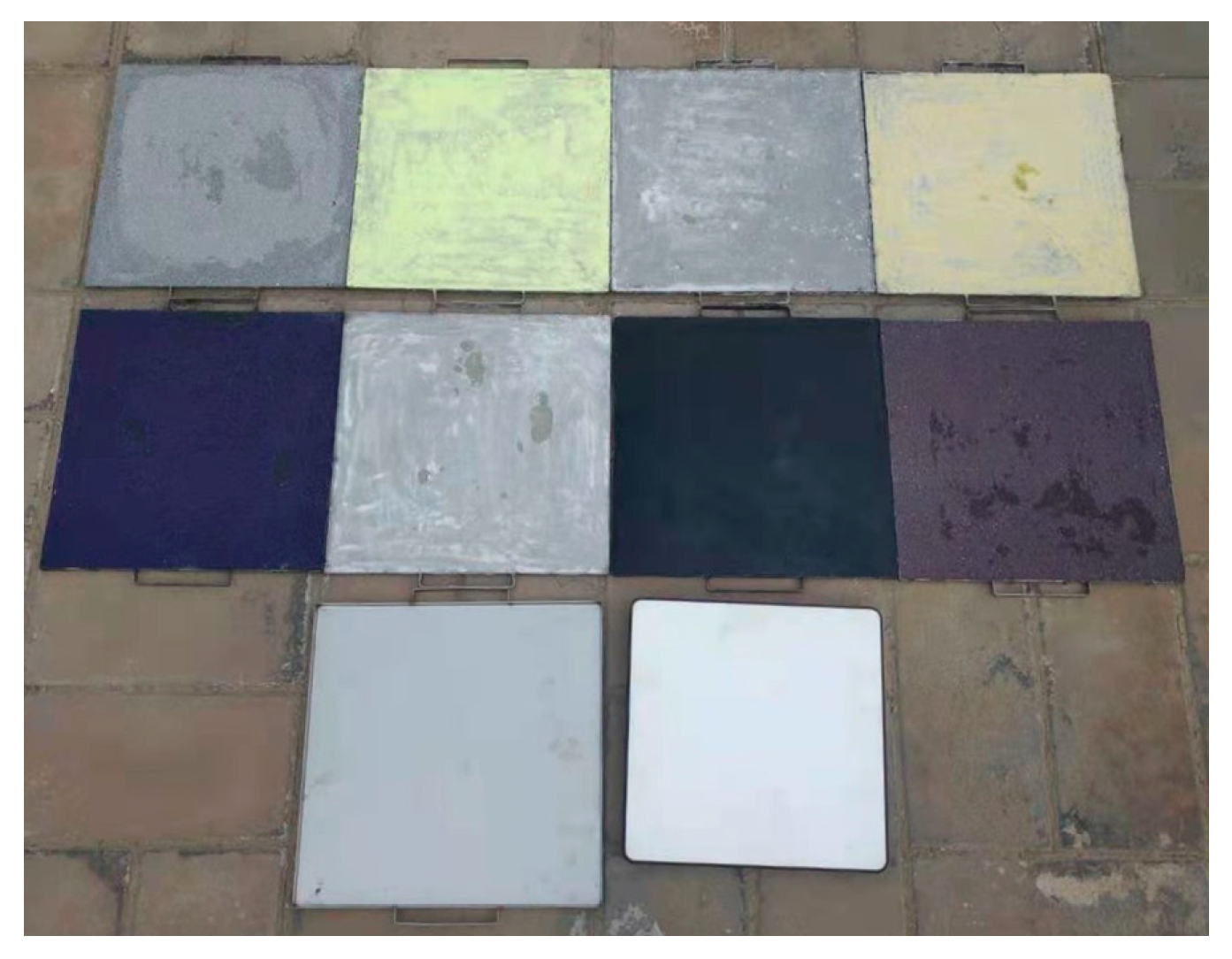

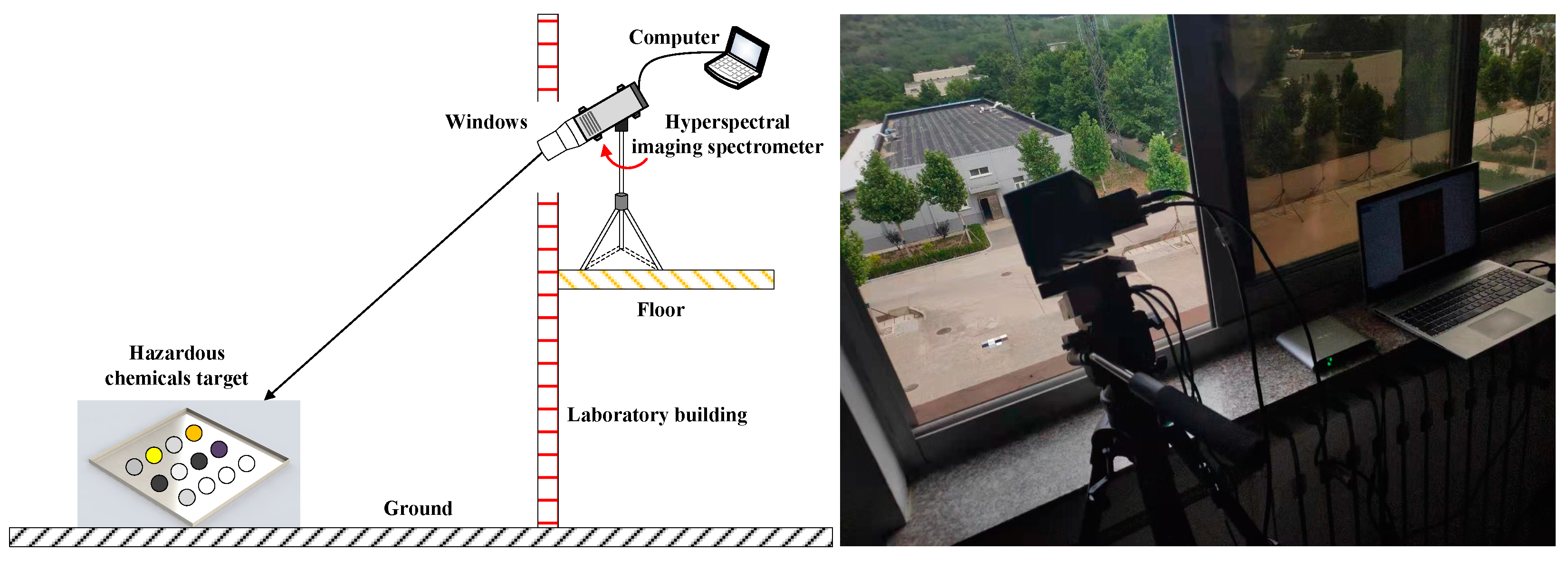
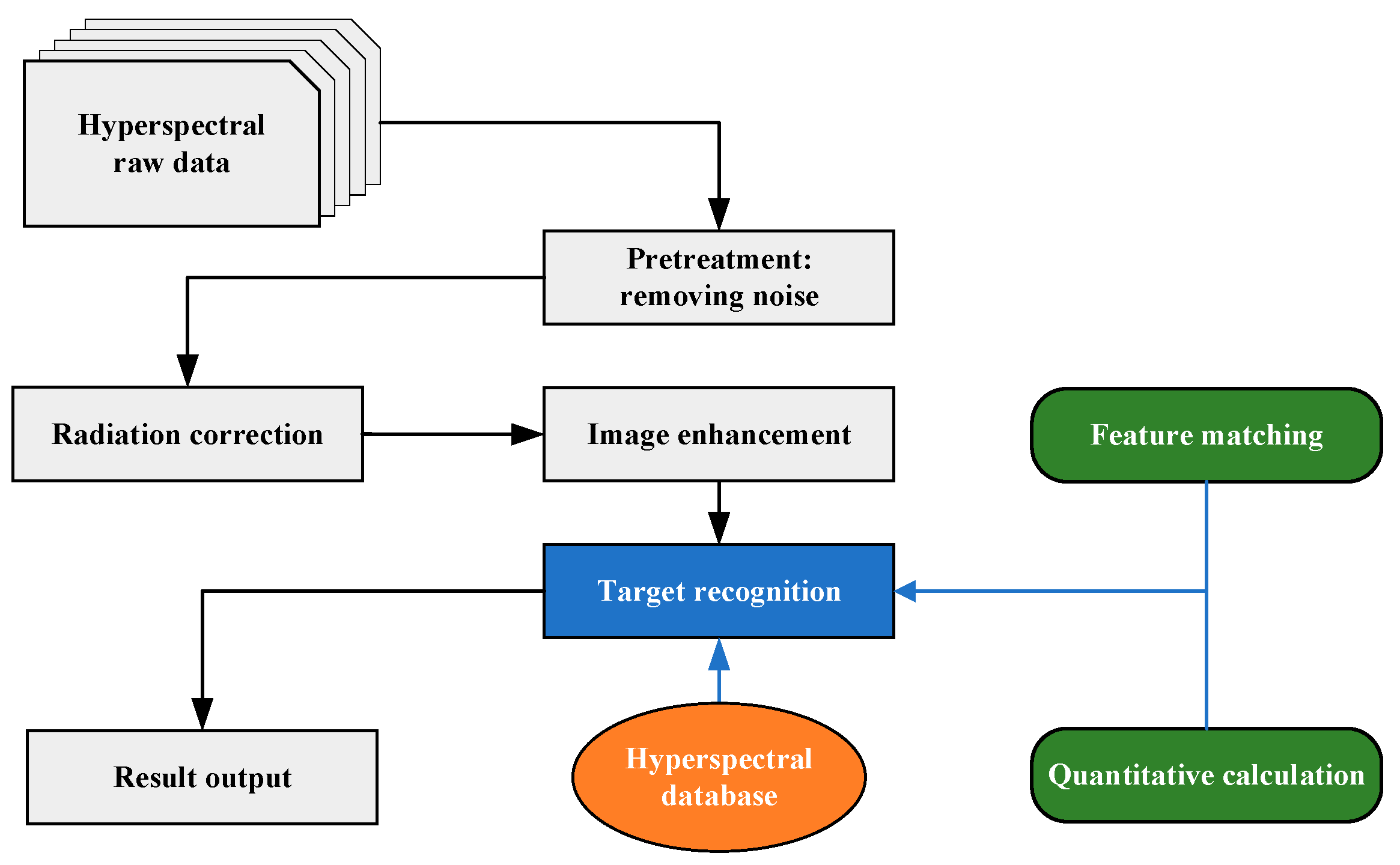
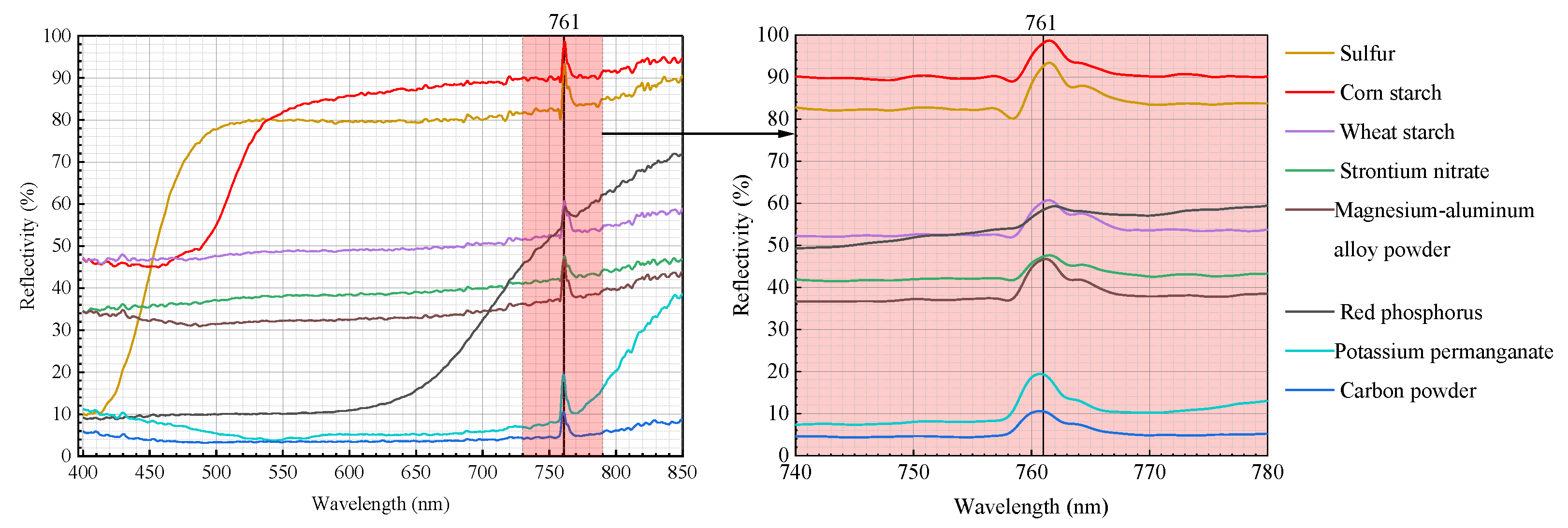
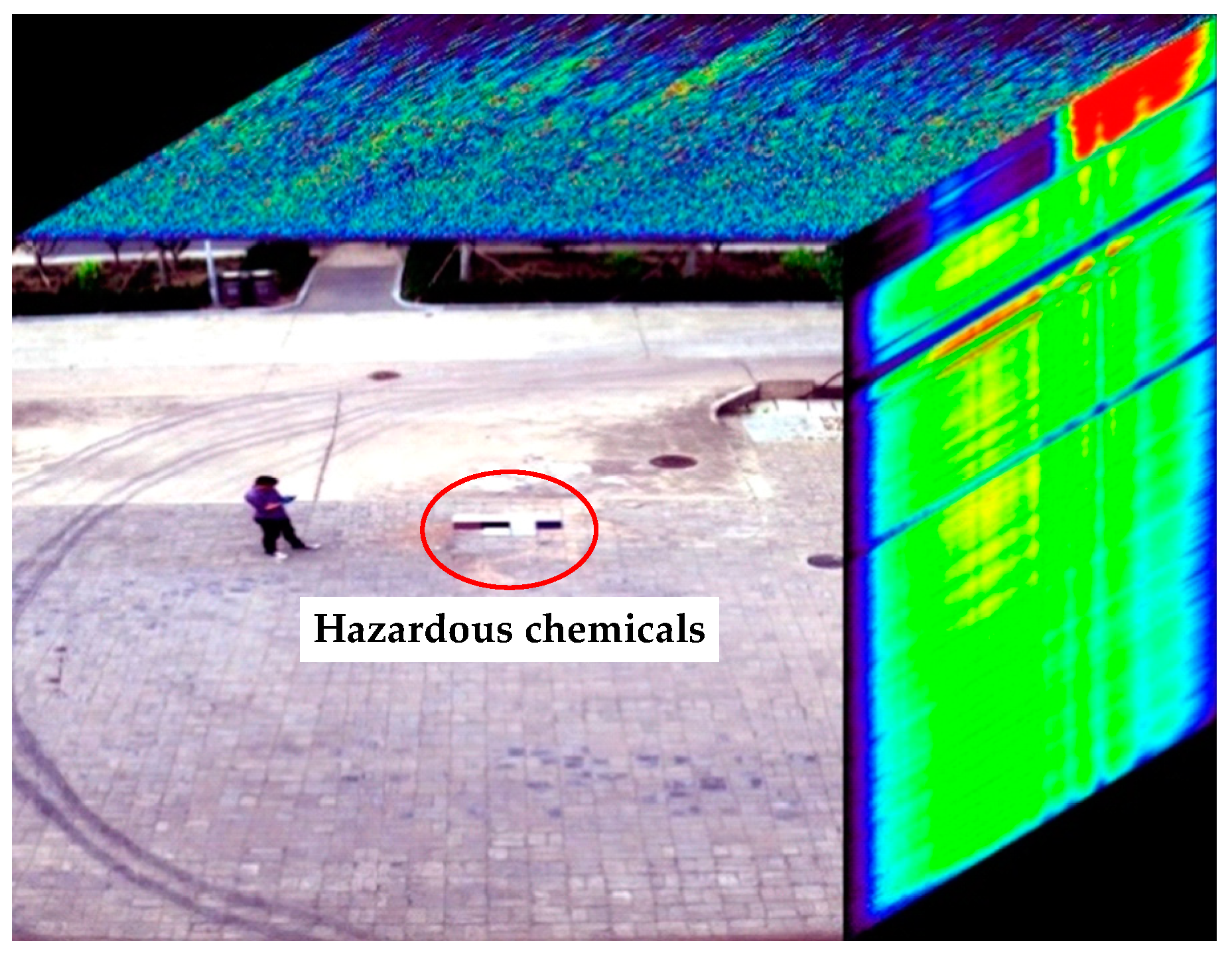
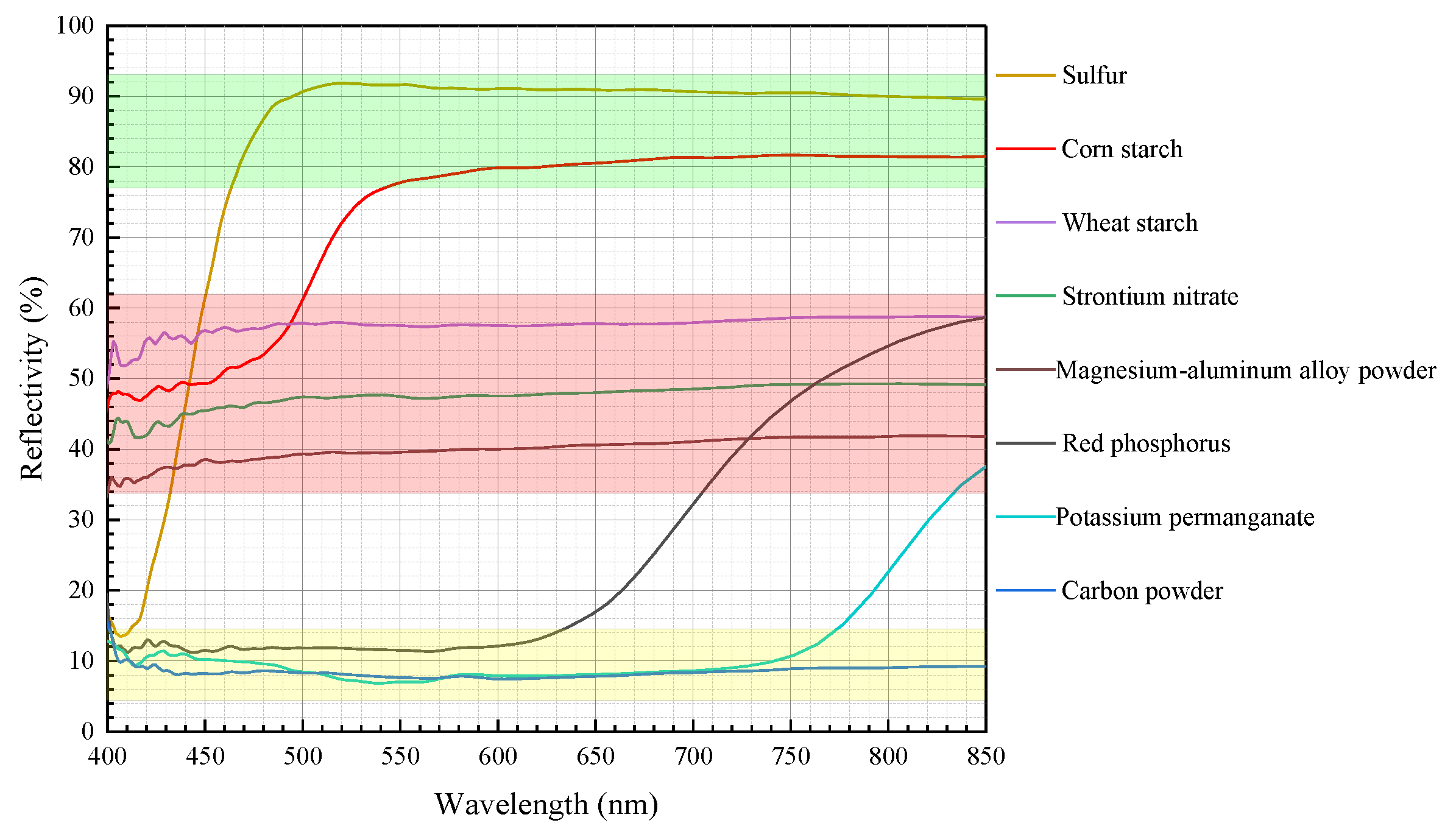
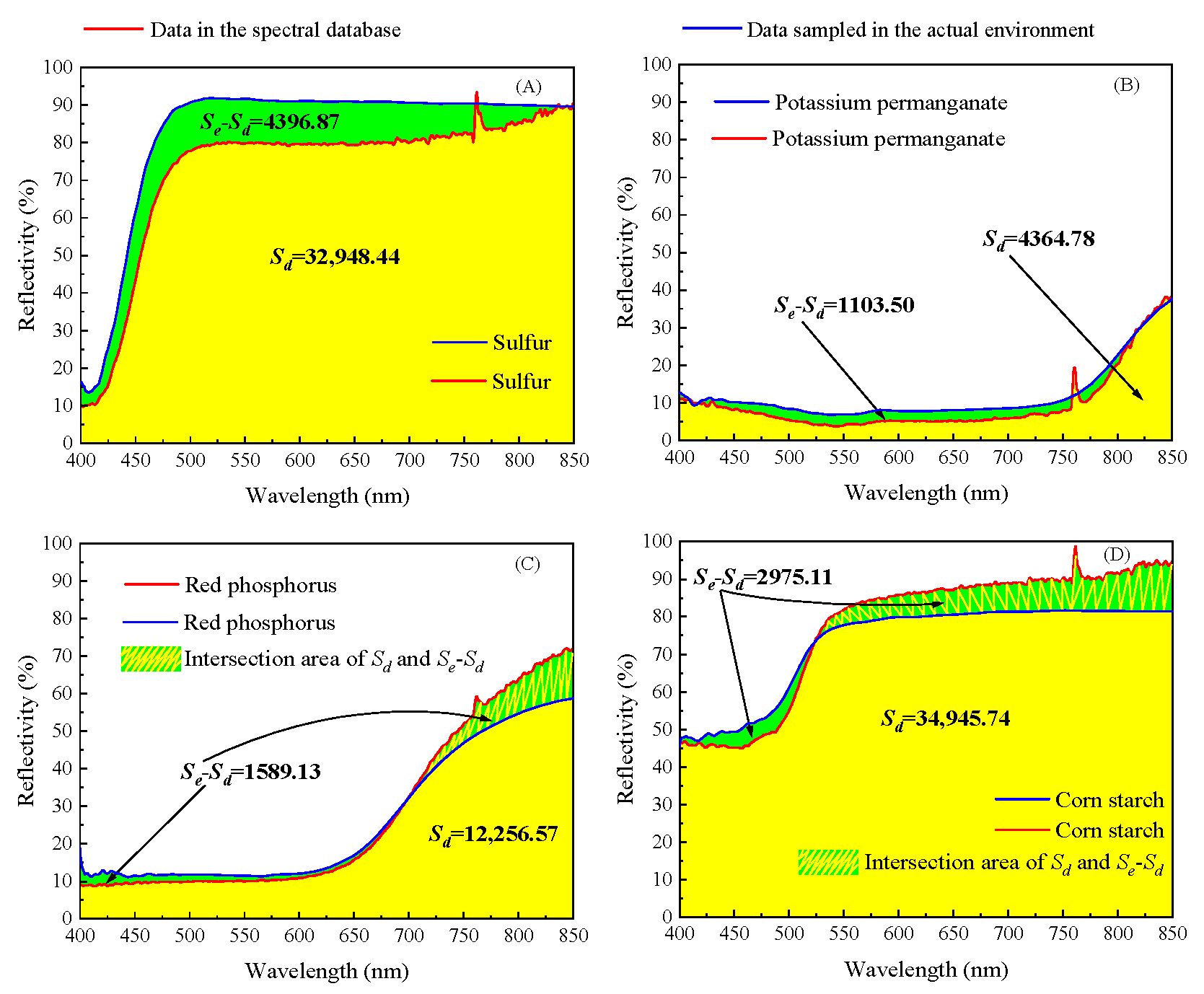
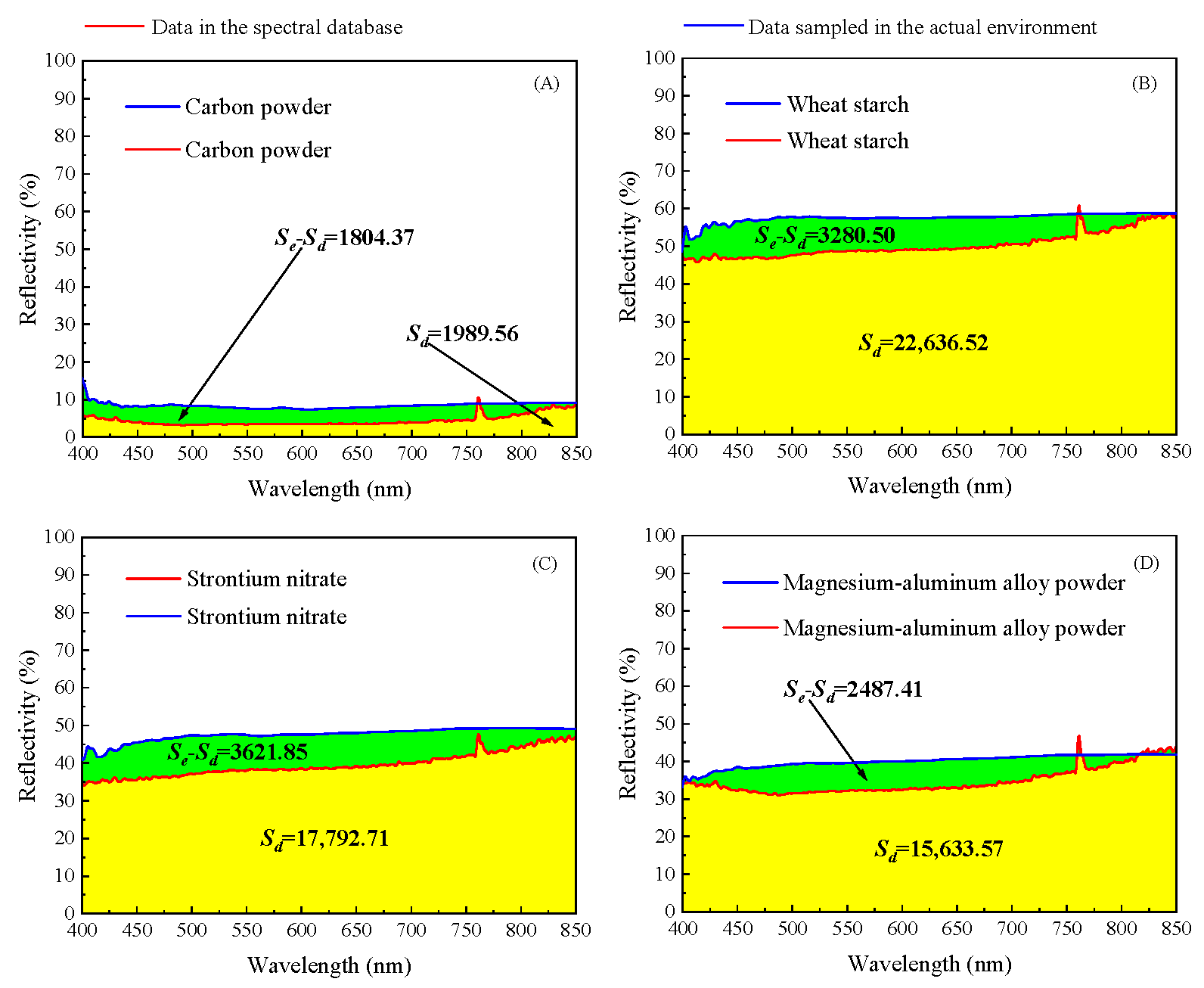
| No. | Sample | Density (g·cm−3) | Color | Purity |
|---|---|---|---|---|
| 1 | Red phosphorus | 2.34 | Reddish-brown | AR |
| 2 | Corn starch | 0.55 | Pale yellow | LR |
| 3 | Carbon powder | 0.45 | Black | AR |
| 4 | Strontium nitrate | 2.99 | White | AR |
| 5 | Wheat starch | 0.48 | White | LR |
| 6 | Sulfur | 2.07 | Yellow | CP |
| 7 | Potassium permanganate | 2.70 | Black purple | AR |
| 8 | Magnesium–aluminum alloy powder | 2.66 | Silver gray | CP |
| No. | Hazardous Chemicals | Se-Sd | Sd | p |
|---|---|---|---|---|
| 1 | Sulfur | 4396.87 | 32,948.44 | 86.66% |
| 2 | Potassium permanganate | 1103.50 | 4364.78 | 74.72% |
| 3 | Red phosphorus | 1589.13 | 12,256.57 | 87.03% |
| 4 | Corn starch | 2975.11 | 34,945.74 | 91.49% |
| 5 | Carbon powder | 1804.37 | 1989.56 | 9.31% |
| 6 | Wheat starch | 3280.50 | 22,636.52 | 85.51% |
| 7 | Strontium nitrate | 3621.85 | 17,792.71 | 79.64% |
| 8 | Magnesium–aluminum alloy powder | 2487.41 | 15,633.57 | 84.09% |
Publisher’s Note: MDPI stays neutral with regard to jurisdictional claims in published maps and institutional affiliations. |
© 2021 by the authors. Licensee MDPI, Basel, Switzerland. This article is an open access article distributed under the terms and conditions of the Creative Commons Attribution (CC BY) license (https://creativecommons.org/licenses/by/4.0/).
Share and Cite
Sun, Y.; Qian, X.; Liu, Y.; Wang, J.; Lv, Q.; Yuan, M. Identification of Typical Solid Hazardous Chemicals Based on Hyperspectral Imaging. Remote Sens. 2021, 13, 2608. https://doi.org/10.3390/rs13132608
Sun Y, Qian X, Liu Y, Wang J, Lv Q, Yuan M. Identification of Typical Solid Hazardous Chemicals Based on Hyperspectral Imaging. Remote Sensing. 2021; 13(13):2608. https://doi.org/10.3390/rs13132608
Chicago/Turabian StyleSun, Yanlong, Xinming Qian, Yangyang Liu, Jianwei Wang, Qunbo Lv, and Mengqi Yuan. 2021. "Identification of Typical Solid Hazardous Chemicals Based on Hyperspectral Imaging" Remote Sensing 13, no. 13: 2608. https://doi.org/10.3390/rs13132608
APA StyleSun, Y., Qian, X., Liu, Y., Wang, J., Lv, Q., & Yuan, M. (2021). Identification of Typical Solid Hazardous Chemicals Based on Hyperspectral Imaging. Remote Sensing, 13(13), 2608. https://doi.org/10.3390/rs13132608






